Investigation of Electrical Properties and Reliability of GaN-Based Micro-LEDs
Abstract
1. Introduction
2. Materials and Methods
3. Results and Discussion
3.1. Structure dependent effect
3.2. Size dependent effect
3.3. Reliability and Stability
4. Conclusions
Author Contributions
Funding
Acknowledgments
Conflicts of Interest
References
- Hwang, D.; Mughal, A.; Pynn, C.D.; Nakamura, S.; DenBaars, P. Sustained high external quantum efficiency in ultrasmall blue III–nitride micro-LEDs. Appl. Phys. Express 2017, 10, 032101. [Google Scholar] [CrossRef]
- Zhang, L.; Ou, F.; Chong, W.C.; C, Y.; Li, Q. Wafer-scale monolithic hybrid integration of Si-based IC and III–V epi-layers—A mass manufacturable approach for active matrix Micro-LED micro-displays. J. Soc. Inf. Display 2018, 26, 137–145. [Google Scholar] [CrossRef]
- Zhang, K.; Peng, D.; Chong, W.C.; Lau, K.M.; Liu, Z. Investigation of photon-generated leakage current for high-performance active matrix micro-LED displays. IEEE Trans. Electron Devices 2016, 63, 4832–4838. [Google Scholar] [CrossRef]
- Herrnsdorf, J.; Mckendry, J.J.D.; Zhang, S.; Xie, E. Active-Matrix GaN Micro Light-Emitting Diode Display With Unprecedented Brightness. IEEE Trans. Electron Devices 2015, 62, 1–3. [Google Scholar] [CrossRef]
- Chong, W.C.; Cho, W.K.; Liu, Z.J.; Wang, C.H.; Lau, K.M. 1700 pixels per inch (PPI) passive-matrix micro-LED display powered by ASIC. In Proceedings of the 2014 IEEE Compound Semiconductor Integrated Circuit Symposium (CSICS), La Jolla, SD, USA, 19–21 October 2014; pp. 1–4. [Google Scholar]
- Königs, S.; Mayr, S.; Buchner, A. A common type of commercially available LED light source allows for color discrimination performance at a level comparable to halogen lighting. Ergonomics 2019, 62, 1462–1673. [Google Scholar] [CrossRef] [PubMed]
- Li, X.; Member, S.; Wu, L.; Liu, Z.; Yue, C.P. Design and Characterization of Active Matrix LED Microdisplays with Embedded Visible Light. J. Lightwave Technol. 2016, 34, 3449–3457. [Google Scholar] [CrossRef]
- Zhao, Q.; Miao, J.; Zhou, S.; Gui, C.; Tang, B.; Liu, M.; Wan, H.; Hu, J. High-Power GaN-Based Vertical Light-Emitting Diodes on 4-Inch Silicon Substrate. Nanomaterials 2019, 9, 1187. [Google Scholar] [CrossRef]
- Kim, T.; McCall, J.G.; Jung, Y.H.; Huang, X.; Siuda, E.R.; Li, Y.; Lu, C. Injectable, cellular-scale optoelectronics with applications for wireless optogenetics. Science 2013, 340, 211–216. [Google Scholar] [CrossRef]
- Cai, Y.; Zou, X.; Liu, C.; Lau, K.M. Voltage-Controlled GaN HEMT-LED Devices as Fast-Switching and Dimmable Light Emitters. IEEE Electron Device Lett. 2018, 39, 224–227. [Google Scholar] [CrossRef]
- Liu, Z.; Zhang, K.; Liu, Y.; Yan, S.; Kwok, H.S.; Deen, J.; Sun, X. Fully Multi-Functional GaN-based Micro-LEDs for 2500 PPI Micro-displays, Temperature Sensing, Light Energy Harvesting, and Light Detection. IEDM Tech. Dig. 2018, 871–874. [Google Scholar]
- Carreira, J.F.C.; Xie, E.; McKendry, J.J.D.; Guilhabert, B.J.E.; Watson, I.M.; Gu, E.; Dawson, M.D. Dual-Color Micro-LED Transmitter for Visible Light Communication. In Proceedings of the 2018 IEEE Photonics Conference (IPC)), Reston, VA, USA, 30 September–4 October 2018; pp. 1–2. [Google Scholar]
- Carreira, J.F.C.; Guilhabert, B.J.E.; McKendry, J.J.D.; Xie, E.; Mathieson, K.; Watson, I.M.; Gu, E.; Dawson, M.D.; Henderson, R.K. Integration of Micro-LED array on CMOS by transfer printing. In Proceedings of the 2018 IEEE Photonics Conference (IPC), Reston, VA, USA, 30 September–4 October 2018; pp. 1–2. [Google Scholar]
- Lam, K.T.; Lin, W.H.; Shei, S.C.; Lin, N.M.; Chen, W.S.; Chang, S.J. White-Light Emission From GaN-Based TJ LEDs Coated With Red Phosphor. IEEE Electron Device Lett. 2016, 37, 1150–1153. [Google Scholar] [CrossRef]
- Zhang, X.; Li, P.; Zou, X.; Jiang, J.; Yuen, S.H.; Lau, K.M. Active matrix monolithic LED micro-display using GaN-on-Si epilayers." IEEE Photonics Technology Letter. IEEE Photonics Technol. Lett. 2019, 31, 865–868. [Google Scholar] [CrossRef]
- Tang, B.; Miao, J.; Liu, Y.; Wan, H.; Li, N.; Zhou, S.; Gui, C. Enhanced Light Extraction of Flip-Chip Mini-LEDs with Prism-Structured Sidewall. Nanomaterials 2019, 9, 319. [Google Scholar] [CrossRef] [PubMed]
- Xu, J.; Zhang, W.; Peng, M.; Dai, J.; Chen, C. Light-extraction enhancement of GaN-based 395 nm flip-chip light-emitting diodes by an Al-doped ITO transparent conductive electrod. Optic Lett. 2018, 43, 2684–2687. [Google Scholar] [CrossRef]
- Tan, L.; Zhou, Q.; Hu, W.; Wang, H.; Yao, R. Light Extraction Enhancement of InGaN Based Micro Light-Emitting Diodes with Concave-Convex Circular Composite Structure Sidewall. Appl. Sci. 2019, 9, 3458. [Google Scholar] [CrossRef]
- Chen, C.; Chen, H.; Liao, J.; Yu, C.; Wu, M. Fabrication and Characterization of Active-Matrix 960 × 540 Blue GaN-Based Micro-LED Display. IEEE J. Quantum Electron. 2019, 55, 1–6. [Google Scholar] [CrossRef]
- Li, C.-K.; Rosmeulen, M.; Simoen, E.; Wu, Y.-R. Study on the Optimization for Current Spreading Effect of Lateral GaN/InGaN LEDs. IEEE Trans. Electron Devices 2014, 61, 511–517. [Google Scholar] [CrossRef]
- Kwonga, C.Y.; Djurišić, A.B.; Choy, W.C.H.; Li, D.; Xie, M.H.; Chan, W.K.; Cheah, K.W.; Lai, P.T.; Chui, P.C. Efficiency and stability of different tris (8-hydroxyquinoline) aluminium (Alq3) derivatives in OLED applications. Mat. Sci. Eng. 2005, 116, 75–81. [Google Scholar] [CrossRef]
- Son, K.R.; Lee, T.H.; Lee, B.R.; Im, H.S.; Kim, T.G. Nitride-Based Microlight-Emitting Diodes Using AlN Thin-Film Electrodes with Nanoscale Indium/Tin Conducting Filaments. Small 2018, 14, 1801032. [Google Scholar] [CrossRef]
- Son, K.R.; Lee, B.R.; Kim, T.G. Chromium/Nickel-Doped Silicon Oxide Thin-Film Electrode: Mechanism and Application to Microscale Light-Emitting Diodes. ACS Appl. Mater. Interfaces 2018, 10, 40967–40972. [Google Scholar] [CrossRef]
- Liu, Z.J.; Chong, W.C.; Wong, K.M.; Keung, C.W.; Lau, K.M. Investigation of forward voltage uniformity in monolithic light-emitting diode arrays. IEEE Photonics Technol. Lett. 2013, 25, 1290–1293. [Google Scholar] [CrossRef]
- Liu, Z.J.; Chong, W.C.; Wong, K.M.; Lau, K.M. 360 PPI flip-chip mounted active matrix addressable light emitting diode on silicon (ledos) micro-displays. IEEE/OSA J. Disp. Technol. 2013, 9, 678–682. [Google Scholar]
- Zhang, K.; Peng, D.; Lau, K.M.; Liu, Z. Fully-integrated active matrix programmable UV and blue micro-LED display system-on-panel (SoP). J. Soc. Inf. Disp. 2017, 25, 240–248. [Google Scholar] [CrossRef]
- Tian, P.; McKendry, J.J.; Gong, Z.; Guilhabert, B.; Watson, I.M.; Gu, E.; Dawson, M.D. Size-dependent efficiency and efficiency droop of blue InGaN micro-light emitting diodes. Appl. Phys. Lett. 2012, 101, 231110. [Google Scholar] [CrossRef]
- Tian, P.; Mckendry, J.J.D.; Gong, Z.; Guilhabert, B.; Waston, I.M.; Gu, E.; Chen, Z.; Zhang, G.; Dawson, M.D. Fabrication, characterization and applications of flexible vertical InGaN micro-light emitting diode arrays. Opt. Express 2016, 24, 699. [Google Scholar] [CrossRef]
- Olivier, F.; Tirano, S.; Dupré, L.; Aventurier, B.; Largeron, C.; Templier, F. Influence of size-reduction on the performances of GaN-based Micro-LEDs for display application. J. Lumin. 2017, 191, 112–116. [Google Scholar] [CrossRef]
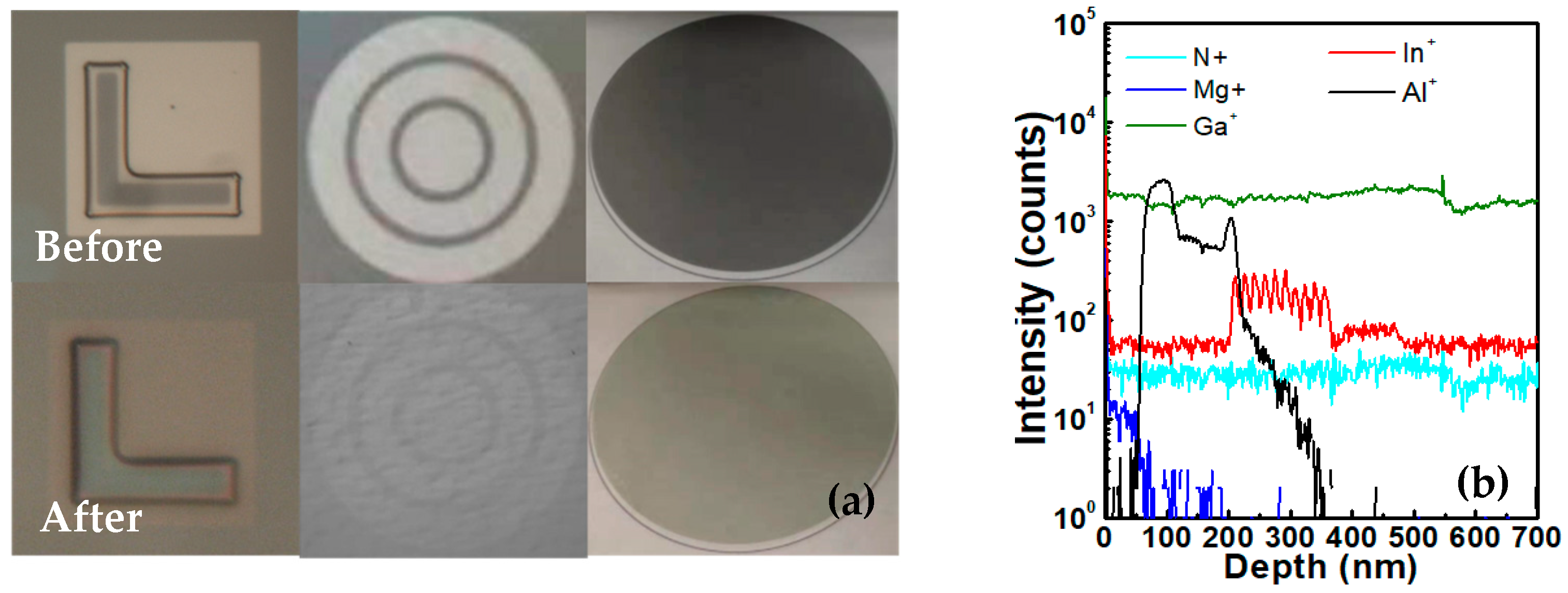
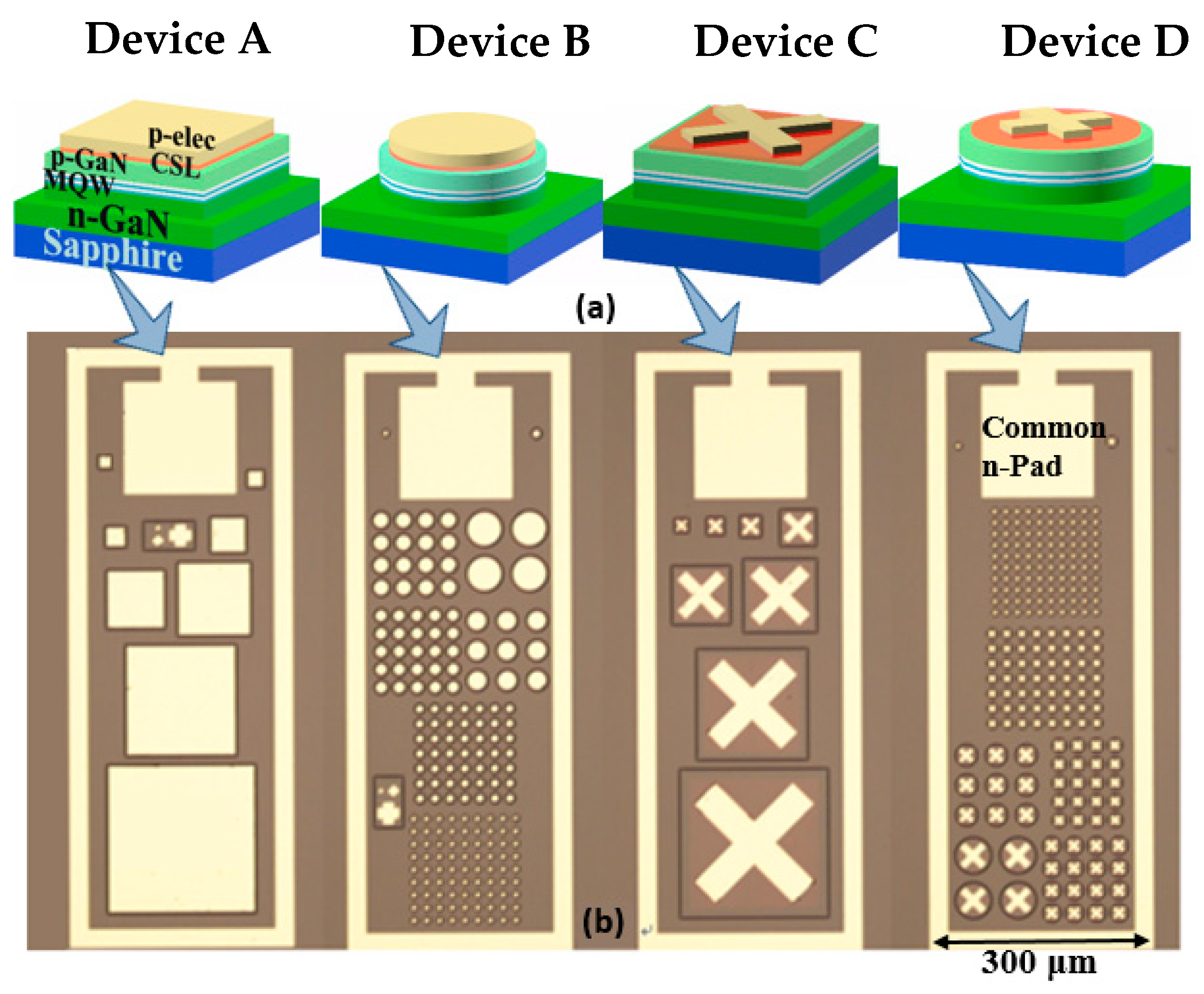
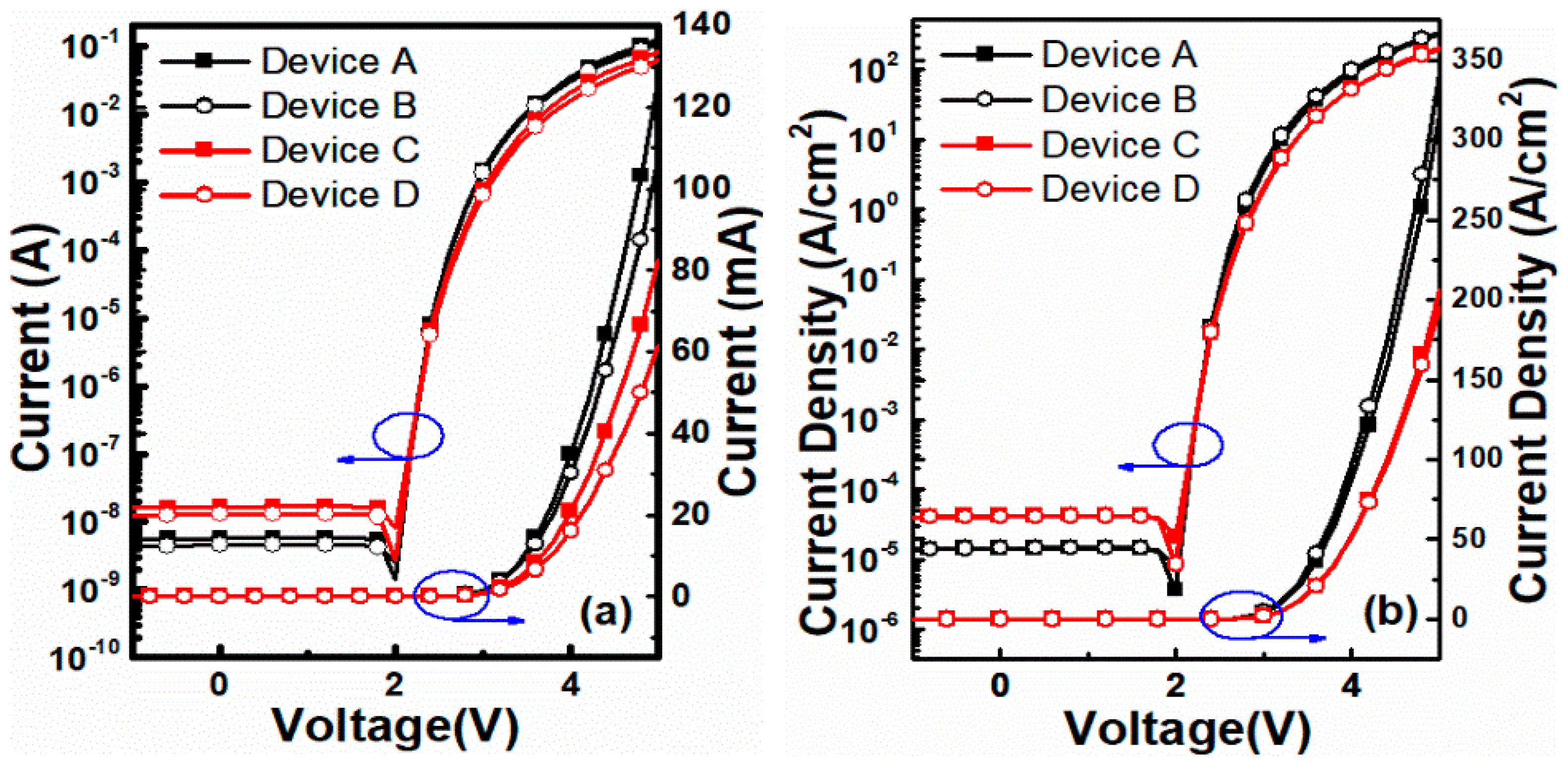
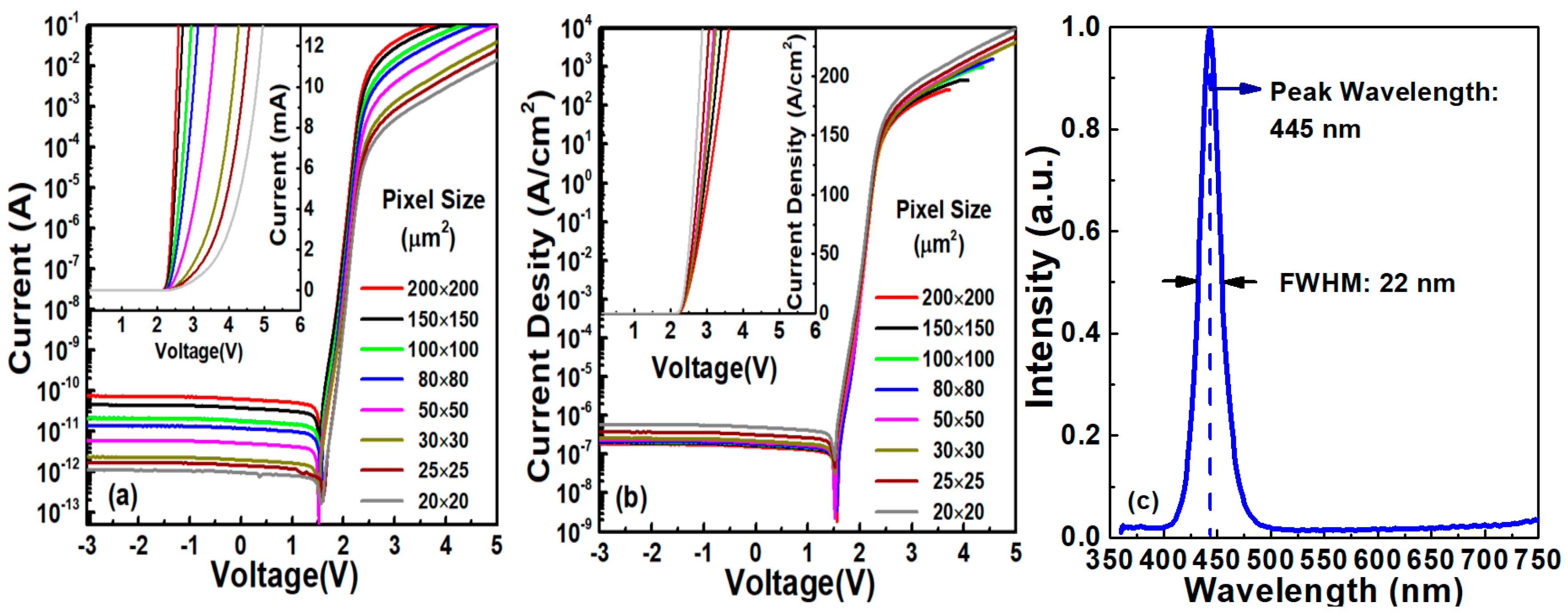
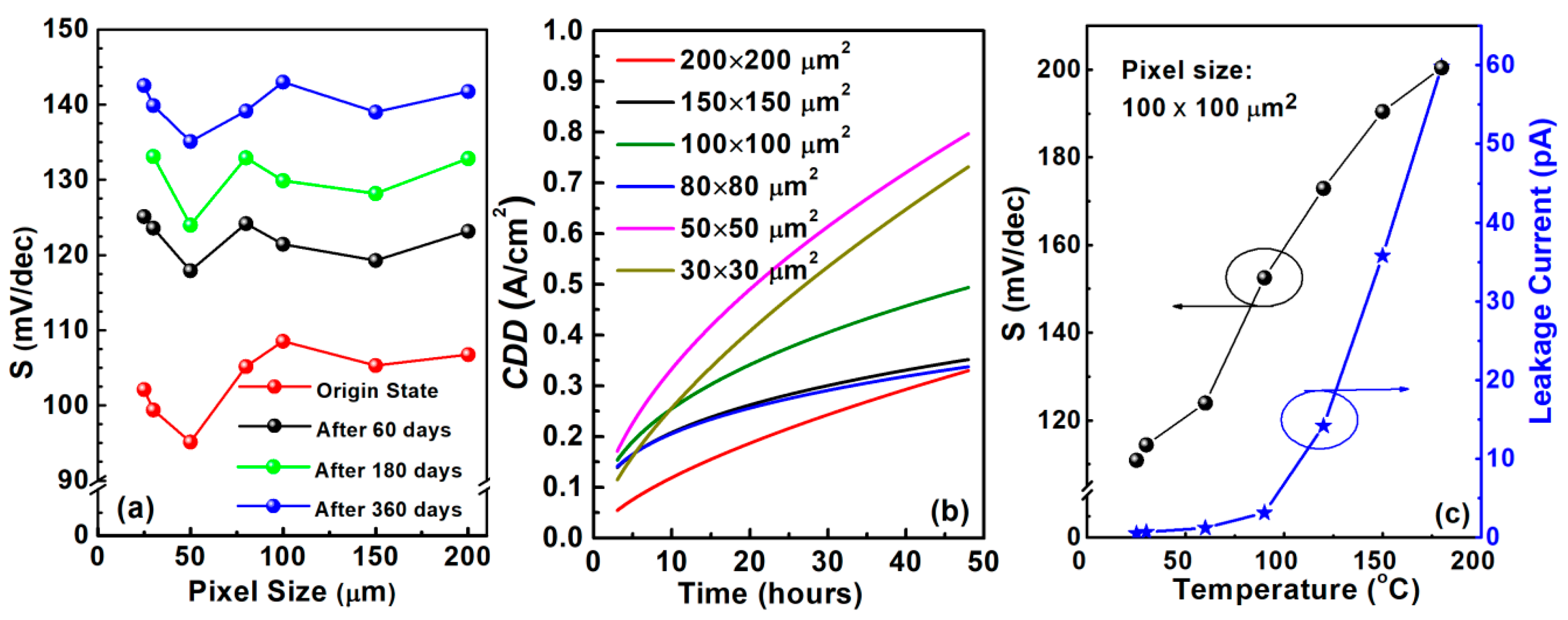
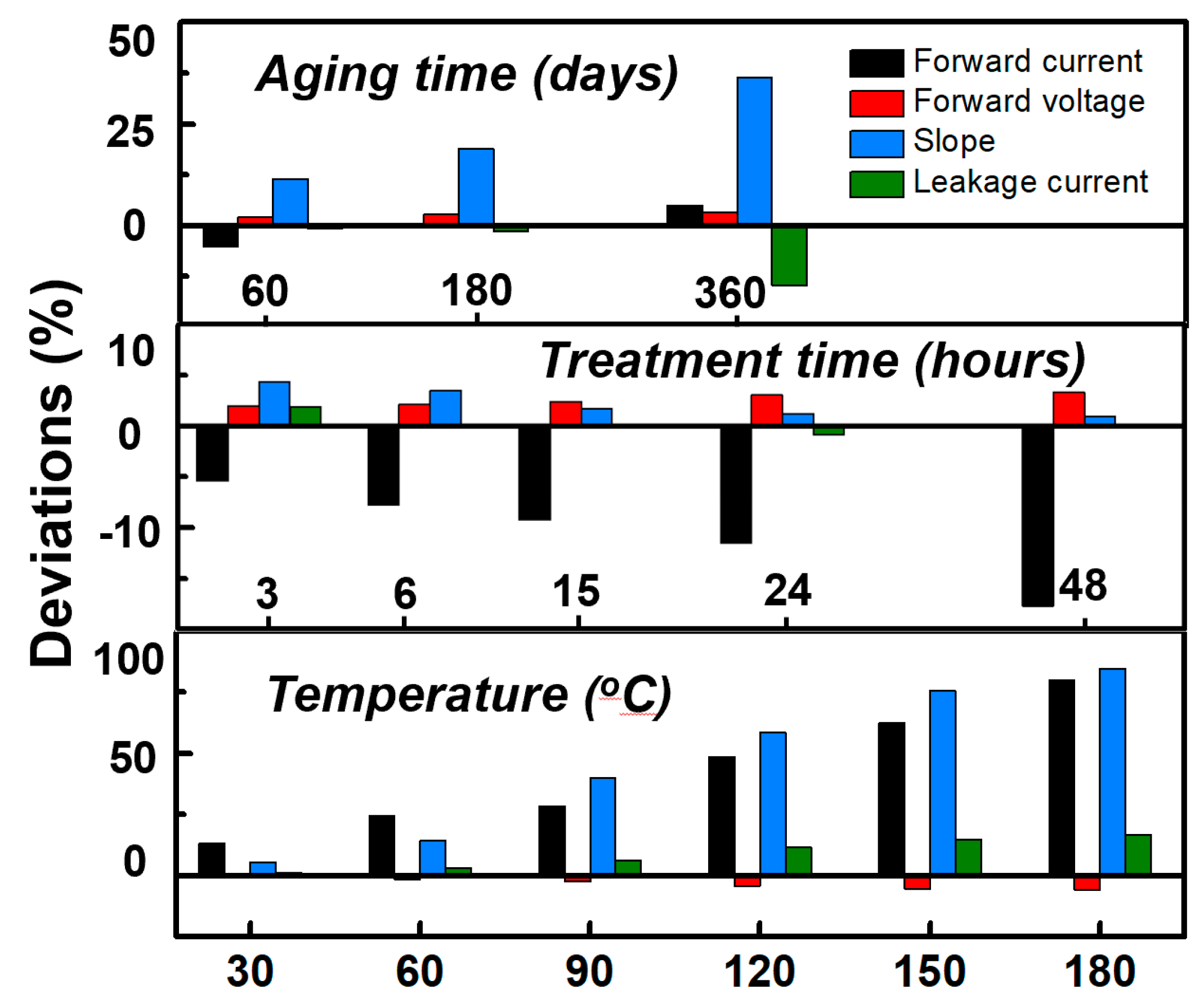
| Condition | I (mA) @ 3V | VF (V) @ 10A/cm2 | S (mV/dec) | leakage (A) @ −5V | |
|---|---|---|---|---|---|
| Aging (days) | 0 | 13 | 2.43 | 108.5 | 5.3E−13 |
| 60 | 12 | 2.48 | 121 | 4.3E−13 | |
| 180 | 13 | 2.50 | 129 | 3.7E−13 | |
| 360 | 14 | 2.51 | 148 | 8.4E−15 | |
| Temperature (°C) | 25 | 13 | 2.43 | 108.5 | 5.3E−13 |
| 30 | 17 | 2.42 | 114.4 | 7.1E−13 | |
| 60 | 17 | 2.39 | 124 | 1.2E−12 | |
| 90 | 17 | 2.37 | 152 | 3.2E−12 | |
| 120 | 19 | 2.33 | 172 | 1.4E−11 | |
| 150 | 21 | 2.3 | 190.4 | 3.6E−11 | |
| 180 | 23 | 2.29 | 200.4 | 6.0E−11 | |
| Humidity (hours) | 0 | 14 | 2.43 | 108.6 | 5.2E−13 |
| 3 | 12 | 2.48 | 113.2 | 8.7E−13 | |
| 6 | 13 | 2.48 | 116.2 | 5.0E−13 | |
| 15 | 12 | 2.49 | 110.3 | 5.5E−13 | |
| 24 | 12 | 2.50 | 109.8 | 4.1E−13 | |
| 48 | 11 | 2.51 | 109.6 | 5.4E−13 |
| Pixel Size (µm) | This Work | University of Strathclyde | Korea University | HKUST | Fudan University | LETI |
|---|---|---|---|---|---|---|
| 20 | 9902 | - | - | - | - | 70 [29] |
| 25 | 6338 | 1500 [13] | - | - | 1750 [27] | - |
| 30 | 4700 | - | 200 [22] | - | - | - |
| 50 | 4400 | - | 4000 [23] | 825 [24] | 1000 [27] | 30 [29] |
| 80 | 2077 | 1400 [13] | - | 918 [25] | 937 [28] | - |
| 100 | 1700 | 150 [14] | - | 90 [26] | 712 [28] | - |
© 2020 by the authors. Licensee MDPI, Basel, Switzerland. This article is an open access article distributed under the terms and conditions of the Creative Commons Attribution (CC BY) license (http://creativecommons.org/licenses/by/4.0/).
Share and Cite
Zhang, K.; Liu, Y.; Kwok, H.-s.; Liu, Z. Investigation of Electrical Properties and Reliability of GaN-Based Micro-LEDs. Nanomaterials 2020, 10, 689. https://doi.org/10.3390/nano10040689
Zhang K, Liu Y, Kwok H-s, Liu Z. Investigation of Electrical Properties and Reliability of GaN-Based Micro-LEDs. Nanomaterials. 2020; 10(4):689. https://doi.org/10.3390/nano10040689
Chicago/Turabian StyleZhang, Ke, Yibo Liu, Hoi-sing Kwok, and Zhaojun Liu. 2020. "Investigation of Electrical Properties and Reliability of GaN-Based Micro-LEDs" Nanomaterials 10, no. 4: 689. https://doi.org/10.3390/nano10040689
APA StyleZhang, K., Liu, Y., Kwok, H.-s., & Liu, Z. (2020). Investigation of Electrical Properties and Reliability of GaN-Based Micro-LEDs. Nanomaterials, 10(4), 689. https://doi.org/10.3390/nano10040689






